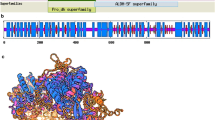Abstract.
The phototrophic bacterium Rhodobacter capsulatus utilizes the aromatic amino acids L-phenylalanine and L-tyrosine as nitrogen source. L-Phenylalanine is hydroxylated to L-tyrosine, which is further converted into p-hydroxyphenyl pyruvate (pHPP) by a transamination reaction. The bacterium is unable to grow at the expense of these amino acids as the sole carbon source, although it is able to degrade them to homogentisate, probably by unspecific hydroxylation reactions. Metabolization of L-phenylalanine or L-tyrosine as nitrogen source requires phototrophic growth conditions and does not produce free ammonium inside the cells. A low aminotransferase activity with 2-oxoglutarate and L-tyrosine as substrates can be detected in crude extracts of R. capsulatus. Uptake of both amino acids by R. capsulatus was completely inhibited by ammonium addition, which also prevents aminotransferase induction.
Similar content being viewed by others
Author information
Authors and Affiliations
Additional information
Received: 21 July 1998 / Accepted: 19 August 1998
Rights and permissions
About this article
Cite this article
Sáez, L., Castillo, F. & Caballero, F. Metabolism of L-Phenylalanine and L-Tyrosine by the Phototrophic Bacterium Rhodobacter capsulatus . Curr Microbiol 38, 51–56 (1999). https://doi.org/10.1007/PL00006772
Issue Date:
DOI: https://doi.org/10.1007/PL00006772



